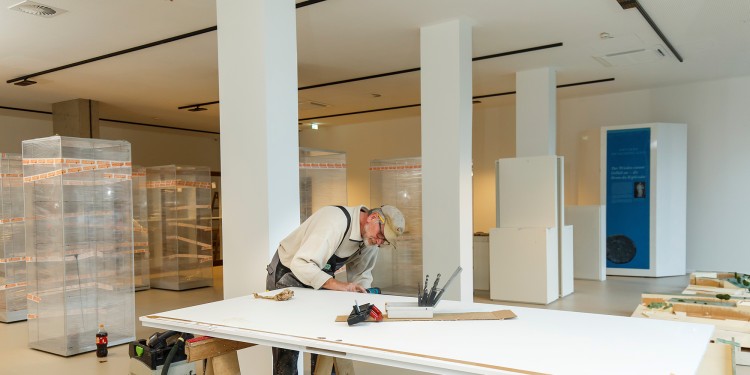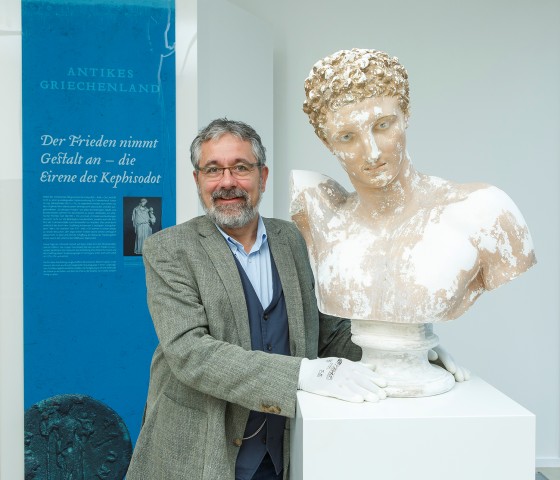
"Antiquity in a modern look"
Lots of showcases – still empty, but bearing notes indicating what they are to contain. Annotations on the walls, indicating years and epochs, as well as basic concepts of antiquity such as 'mythology', 'cult of the dead' and 'gods'. And a few workmen amid the unfinished surroundings. The exhibition of various archaeologies of the University of Münster in Fürstenberghaus is currently undergoing a revival. Sketches show what is still to come. Looking through the window façade on Domplatz, Greek and Roman antiquity can still as yet only be guessed at.
Walking through the modernised, barrier-free museum – which is increasing in size from 250 to just over 500 square metres – is a fascinating experience because the new features are already becoming noticeable. As is the pride expressed in the words of Dr. Helge Nieswandt: "The 'one-room' era is over. We’re a real museum now," declares the curator of the Archaeological Museum. It is one of the sites of the new Museum Mile emerging in Münster’s Pferdegasse, and the University has invested almost 1.5 million euros. Just to make the dimensions clearer to anyone who knows the locality: in the old days, any visitors standing at the entrance to the museum were able to see the whole museum when they saw just the one room before them (the Lothar Zelz Hall). At that time, just a quarter of an hour was all that was needed to walk through antiquity (without a guided tour).
Today, the ground floor houses a reception with a small shop – permanently staffed during the museum’s opening hours. A tour begins with the first showcases, containing antique coins from the Greek and Roman eras, as well as a quote from Goethe: "The present cannot be recognised without knowing the past". This adage exemplifies the aims which the University museum has: "We represent all the archaeologies to be found at the University – not only for students, but also for the public," as the museum’s director, Prof. Achim Lichtenberger, explains. These archaeologies include classical archaeology (Greece, Rome), Middle Eastern archaeology (Assyria, Babylon, Persia), the archaeology of Ancient Egypt and of pre- and early history, early Christian, Byzantine and early Islamic cultural history, as well as – and this is new – loans from the City of Münster’s Department of Monument Conservation and Archaeology for the city’s history.

On the ground floor there are rows of showcases on general topics such as war, peace, medicine, education and sport. The centre of the room is taken up with a large-scale model of the marketplace in Athens, the ‘agora’, which stands for the cradle of democracy and provides a reminder of what is still today one of the foundations of communal life. There is, in addition, a model of Eirene, goddess of peace, made especially for the large Peace exhibition in Münster, as well as a bronze-coloured plaster cast of the statue originally made by the Greek sculptor Cephisodotus.
On the way down into the basement – what used to be a cellar housing bicycles in Fürstenberghaus – the juxtaposition of the stairs and the lift display further noticeable changes. The entire museum is now barrier-free and has a cloakroom and its own toilets area. There is air-conditioning and LED lighting, as well as sunshading technology for the window façade on the ground floor, protecting the interior from any excessive fluctuations in temperature. "All the lettering is in German and English, and the information boards at ground level can be easily read by adults, children and wheelchair-users alike," Helge Nieswandt proudly adds.
In the basement, every historian of antiquity has a place for his or her special field of interest. As visitors enter, a beamer provides an eyecatcher of a constantly changing series of large landscape photos. These provide geographical contexts for all the cultural areas covered by this room of exhibits. A timeline on the long wall – beginning in the 8th century BCE and ending with Münster’s first bishop, Liudger, in the 8th century CE – shows all the different epochs from antiquity up to the conversion of Münster to Christianity. A large map of the Mediterranean area also shows geographical contexts.
The dozens of boxes soon to be unpacked will be joined later – 2021 is the planned date – by a further impressive exhibit: the famous, elaborately restored "mummy of Münster". The ancient Egyptian wooden coffin containing a mummy – currently on loan from an exhibition of mummies being shown at five locations in Japan – is designed to be the main attraction in the Archaeological Museum. Not forgetting, of course, that the Museum itself is the attraction.
Author: Juliane Albrecht
Service for visitors
On the day the museum opens – Friday, 13 December – the public will have access to the Archaeological Museum and to the Bible Museum from 7:30 pm onwards. From 14 December, both museums will be open daily from 10 am to 6 pm (closed on Mondays) – reflecting the opening times of the LWL Museum of Art and Culture opposite. On so-called 'long Fridays' (the second Friday in every month), the museums will be open from 10 am to 10 pm.
Contact
Archaeological Museum:
Tel.: 0251 83-25412
email: archmus@uni-muenster.de
This article was first published in the University newspaper wissen|leben, No. 7, November 2019.
